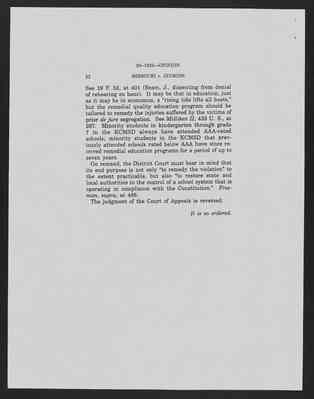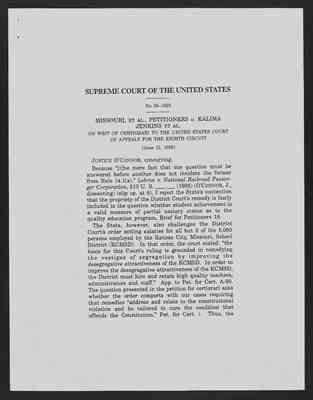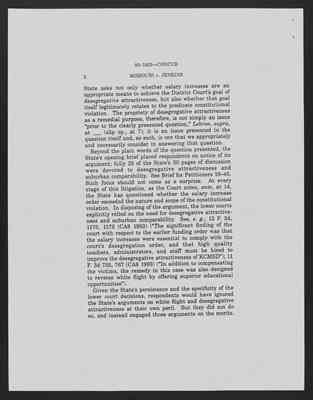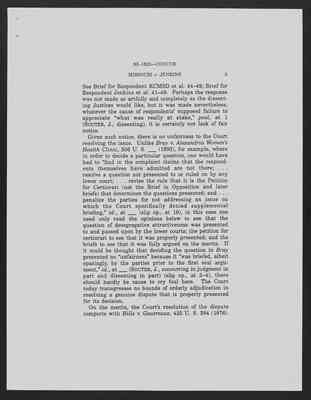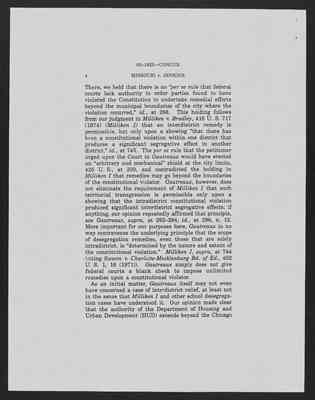Pages
36
93-1823-OPINION
32 MISSOURI v. JENKINS
See 19 F. 3d, at 401 (Beam, J., dissenting from denial of rehearsing en banc). It may be that in education, just as it may be in economics, a "rising tide lifts all boats," but the remedial quality education program should be tailored to remedy the injuries suffered by the victims of prior de jure segregation, See Milliken II, 433 U.S., at 287. Minority students in kindergarten through grade 7 in the KCMSD always have attended AAA-rated schools; minority students in the KCMSD that previously attended schools rated below AAA have since received remedial education programs for a period of up to seven years.
On remand, the District Court must bear in mind that its end purpose is not only "to remedy the violation" to the extent practicable, but also "to restore state and local authorities to the control of a school system that is operating in compliance with the Constitution." Freeman, supra, at 489.
The judgment of the Court of Appeals is reversed.
It is so ordered.
37
SUPREME COURT OF THE UNITED STATES -------------------- No. 93-1823 -------------------- MISSOURI , ET AL, PETITIONERS v. KALIMA JENKINS ET AL. ON WRIT OF CERTIORARI TO THE UNITED STATES COURT OF APPEALS FOR THE EIGHTH CIRCUIT
[June 12, 1995]
JUSTICE O'CONNOR, concurring.
Because "[t]he mere fact that one question must be answered before another does not insulate the former from Rule 14.1(a)," Lebron v. National Railroad Passenger Corporation, 513 U.S. ___, ___ (1995) (O'CONNOR, J., dissenting) (slip op. at 6), I reject the State's contention that the propriety of the District Court's remedy is fairly included in the question whether student achievement is a valid measure of partial unitary status as to the quality education program, Brief for Petitioners 18.
The State, however, also challenges the District Court's order setting salaries for all but 3 of the 5,000 persons employed by the Kansas City, Missouri, School District (KCMSD). In that order, the court states: "the basis for this Court's ruling is grounded in remedying the vestiges of segregation by improving the desegregative attractiveness of the KCMSD. In order to improve the desegregative attractiveness of the KCMSD, the District must hire and retain high quality teachers, administrators and staff." App. to Pet. for Cert. A-90. The question presented in the petition for certiorari asks whether the order omports with our cases requiring that remedies "address and relate to the constitutional violation and be tailored to cure the condition that offends the Constitution." Pet. for Cert. i. Thus, the
38
93-1823-CONCUR [page] 2 MISSOURI v. JENKINS
State asks not only whether salary increases are an appropriate means to achieve the District Court's goal of desegregative attractiveness, but also whether that goal itself legitimately relates to the predictate constitutional violation. The propriety of desegregative attractiveness as a remedial purpose, therefore, is not simply an issue "prior to the clearly presented question." Lebron, supra, at ____ (slip op., at 7); it is an issue presented in the question itself and, as such, is one that we appropriately and necessarily consider in answering that question.
Beyond the plain words of the question presented, the State's opening brief placed respondents on notice of its argument; fully 25 of the State's 30 pages of discussion were devoted to desegregative attractiveness and suburban comparability. See Brief for Petitioners 19-45. Such focus should not come as a surprise. At every state of this litigation, as the Court notes, ante, at 14, the State has questioned whether the salary increase order exceeded the nature and scope of the constitutional violation. In disposing of the argument, the lower courts explicitly relied on the need for desegregative attractiveness and suburban comparability See, e.g., 13 F. 3d, 1170, 1172 (CA8 1993) ("The significant finding of the court with respect to the earlier funding order was that the salary increases were essential to comply with the court's desegregation order, and that high quality teachers, administrators, and staff must be hired to improve the desegregative attractiveness of KCMSD"); 11 F. 3d 755, 767 (CA8 1993) ("In addition to compensating the victims, the remedy in this case was also designed to reverse white flight by offering superior educational opportunities").
Given the State's persistence and the specificity of the lower court decisions, respondents would have ignored the State's arguments on white flight and desegregative attractiveness at their own peril. But they did not do so, and instead engaged those arguments on the merits.
39
93-1823-CONCUR MISSOURI v. JENKINS [page] 3
See Brief for Respondence KCMSD et al. 44-49; Brief for Respondent Jenkins et al. 41-49. Perhaps the response was not made as artfully and completely as the dissenting Justices would like, but it was mad nevertheless; whatever the cause of respondents' supposed failure to appreciate "whet was really at stake," post, at 1 (SOUTER, J., dissenting), it is certainly not lack of fair notice.
Given such notice, there is no unfairness to the Court resolving the issue. Unlike Bray v. Alexandria Women's Health Cline, 506 U.S. ___ (1993), for example, where in order to decide a particular question, one would have had to "find in the complaint claims that the respondents themselves have admitted are not there; . . . resolve a question not presented to or ruled on by any lower court; . . . revise the rule that it is the Petition for Certiorari (not the Brief in Opposition and later briefs) that determines the questions presented; and . . . penalize the parties for not addressing an issue on which the Court specifically denied supplemental briefing," id., at ____ (slip op., at 16), in this case one need only read the opinions below to see that the question of desegregative attractiveness was presented to and passed upon by the lower courts; the petition for certiorari to see that it was properly presented; and the briefs to see that it was fully argued on the merits. If it could be thought that deciding the question in Bray presented no "unfairness" because it "was briefed, albeit sparingly, by the parties prior to the first oral argument," id., at ___ (SOUTER, J., concurring in judgment in part and dissenting in part) (slip op., at 3-4), there should hardly be cause to cry foul here. The Court today transgresses no bounds of orderly adjudication in resolving a genuine dispute that is properly presented for its decision.
On the merits, the Court's resolution of the dispute comports with Hills v. Gautreaux, 425 U.S. 284 (1976).
40
93-1823-CONCUR [page] 4 MISSOURI v. JENKINS
There, we held that there is no "per se rule that federal courts lack authority to order parties found to have violated the Constitution to undertake remedial efforts beyond the municipal boundaries of the city where the violation occurred." id., at 298. This holding follows from our judgment in Milliken v. Bradley, 418 U.S. 717 (1974) (Milliken I) that an interdistrict remedy is permissible, but only upon a showing "that there has been a constitutional violation within one district that produces a significant segregative effect in another district," id., at 745. The per se rule that the petitioner urged upon the Court in Gautreaux would have erected an "arbitrary and mechanical" shield at the city limits, 425 U.S., at 300, and contradicted the holding in Milliken I that remedies may go beyond the boundaries of the constitutional violator. Gautreaux, however, does not eliminate the requirement of Milliken I that such territorial transgression is permissible only upon a showing that the intradistrict constitutional violation produced significant interdistrict segregative effects; if anything, our opinion repeatedly affirmed that principle, see Gautreaux, supra, at 292-294; id., at 296, n. 12. More important for our purposes here, Gautreaux in no way contravenes the underlying principle that the scope of desegregation remedies, even those that are solely intradistrict, is "determined by the nature and extent of the constitutional violation." Milliken I, supra, at 744 (citing Swann v. Charlotte-Mecklenburg Bd. of Ed., 402 U.S. 1, 16 (1971). Gautreaux simply does not give federal courts a blank check to impose unlimited remedies upon a constitutional violator.
As an initial matter, Gautreaux itself may not even have concerned a case of interdistrict relief, at least not in the sense that Milliken I and other school desegregation cases have understood it. Our opinion made clear that the authority of the Department of Housing and Urban Development (HUD) extends beyond the Chicago
